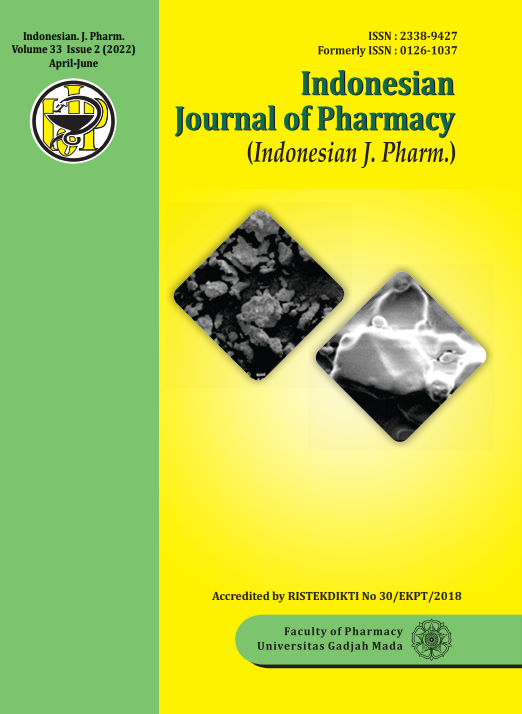Evaluation of Clinical Outcome of Antipsychotic Therapy in Schizophrenic Patients in Palu – Indonesia
Abstract
Schizophrenia is a severe mental disorder characterized by psychotic episodes. The first line of treatment for schizophrenia is the use of antipsychotics that is still subjective. There is still a need for research related to the use of antipsychotics to achieve effective treatment. This study aimed to compare the effectiveness of the First-Generation Antipsychotic (FGA) haloperidol, trifluoperazine and risperidone antipsychotic therapies as Second-Generation Antipsychotic (SGA) based on symptom reduction using the Positive and Negative Syndrome Scale-Excited Component (PANSS-EC) method in patients with acute schizophrenia and relapse hospitalization. This research used a quantitative analysis with a prospective approach where the sampling was conducted using total sampling and the data obtained were analyzed using independent t-test and linear regression analysis. There were 40 out of 120 patients who met the inclusion criteria, consisting of patients in groups of haloperidol, trifluoperazine and risperidone therapies with a therapeutic duration of 3–10 days. The results showed that the average PANSS-EC score of haloperidol medication of 15.35 was greater than that of trifluoperazine medication of 14.42 and the p-value showed no significant difference between the use of FGA, haloperidol and trifluoperazine with p = 0.190 (p> 0.05). The average PANSS-EC score of haloperidol medication (FGA) of 15.35 was greater than that of risperidone (SGA) of 13.6 and the p-value showed that there was a significant difference between haloperidol and risperidone with p = 0.027 (p< 0.05). The multivariate analysis showed p = 0.022 (p< 0.05) which means haloperidol showed the greatest symptom reduction among the three antipsychotic medications.
References
Clark, M.A, R. Finkel, J.A Rey, and K. Whalen. 2012. Lippincott’s Illustrated Reviews Pharmacology 5th Ed. 5th ed. Lippincott Williams & Wilkins.
Davies, A., M. A. Adena, N. A. Keks, S. V. Catts, T. Lambert, and I. Schweitzer. 1998. “Risperidone versus Haloperidol: I. Meta-Analysis of Efficacy and Safety.” Clinical Therapeutics 20 (1): 58–71.
DiPiro, J.T, R.L Talbert, G.C Yee, G.R Matzke, B.G Wells, and L.M Posey. 2011. Pharmacotherapy: A Pathophysiologic Approach. 8th ed. United State of America: Mc Graw Hill. 2017. Pharmacotherapy: A Patophysiologic Approach (10th Ed). 10th ed. New York: Mc Graw Hill Company.
Dold, Markus, Myrto T Samara, Chunbo Li, Magdolna Tardy, and Stefan Leucht. 2015. “Haloperidol versus First-Generation Antipsychotics for the Treatment of Schizophrenia and Other Psychotic Disorders.” Edited by Cochrane Schizophrenia Group. Cochrane Database of Systematic Reviews, January. https://doi.org/10.1002/14651858.CD009831.pub2.
Fahrul, Fahrul, Alwiyah Mukaddas, and Ingrid Faustine. 2014. “The Rationality of the Use of Antipsychotics in Schizophrenia Patients in the Madani Mental Hospital In Central Sulawesi Province in the January-April 2014 Period. ” Natural Science: Journal of Science and Technology 3 (2). https://doi.org/10.2012/.
Hardman, J.G, and L.E Limbird. 2014. Goodman & Gilman: Basic Pharmacological Therapies. Vol. 1. Jakarta: EGC.
Ibrahim, AS. 2010. Skizofrenia Spliting Personality. Tangerang: Jelajah Nusantara.
Marder, Stephen R., Shirley M. Glynn, William C. Wirshing, Donna A. Wirshing, Doreen Ross, Clifford Widmark, Jim Mintz, Robert P. Liberman, and Karen E. Blair. 2003. “Maintenance Treatment of Schizophrenia with Risperidone or Haloperidol: 2-Year Outcomes.” The American Journal of Psychiatry 160 (8): 1405–12. https://doi.org/10.1176/appi.ajp.160.8.1405.
Montoya, Alonso, Amparo Valladares, Luis Lizán, Luis San, Rodrigo Escobar, and Silvia Paz. 2011. “Validation of the Excited Component of the Positive and Negative Syndrome Scale (PANSS-EC) in a Naturalistic Sample of 278 Patients with Acute Psychosis and Agitation in a Psychiatric Emergency Room.” Health and Quality of Life Outcomes 9 (March): 18. https://doi.org/10.1186/1477-7525-9-18.
Ochoa, Susana, Judith Usall, Jesús Cobo, Xavier Labad, and Jayashri Kulkarni. 2012. “Gender Differences in Schizophrenia and First-Episode Psychosis: A Comprehensive Literature Review.” Schizophrenia Research and Treatment 2012: 1–9. https://doi.org/10.1155/2012/916198.
Ohi, Kazutaka, Chika Sumiyoshi, Haruo Fujino, Yuka Yasuda, Hidenaga Yamamori, Michiko Fujimoto, Tomoko Shiino, Tomiki Sumiyoshi, and Ryota Hashimoto. 2018. “Genetic Overlap between General Cognitive Function and Schizophrenia: A Review of Cognitive GWASs.” International Journal of Molecular Sciences 19 (12): 3822. https://doi.org/10.3390/ijms19123822.
Pramudianto, A., and Evaria. 2016. MIMS Indonesia Consultation Instructions. 16th ed. Jakarta.
Purwandityo, Ayuningtyas G., Yosi Febrianti, Chynthia P. Sari, Vitarani D. A. Ningrum, and
Okky P. Sugiyarto. 2018. “Effect of Antipsychotics on Score Reduction of The Positive and Negative Syndrome Scale-Excited Component.” Indonesian Journal of Clinical Pharmacy 7 (1): 19–29. https://doi.org/10.15416/ijcp.2018.7.1.19.
Ranti, Imaniar, Andi Fauziyar Octaviany, and Sekar Kinanti. 2015. “Analysis of the Effectiveness of Therapy and the Cost Between Combined Haloperidol and Combined Risperidone in Acute Phase Schizophrenia Therapy. " Mutiara Medika: Journal of Medicine and Health 15 (1): 57–64. “RISKESDAS 2018.” n.d. Accessed February 3, 2019. http://labdata.litbang.depkes.go.id/menu-progress-puldata/progress-puldata-rkd-2018.
Saperstein, AM, JM Fizsdon, and MD Bell. 2011. “Intrinsic Motivation as a Predictor of Work Outcome after Vocational Rehabilitation in Schizophrenia. J Nerv Ment Dis 199: 672-677.” 2011. https://www.researchgate.net/publication/51606571_Saperstein_AM_Fiszdon_JM_Bell_MD_Intrinsic_motivation_as_a_predictor_of_work_outcome_after_vocational_rehabilitation_in_schizophrenia_J_Nerv_Ment_Dis_199_672-677.
Sianturi, F.L. 2010. “Differences in the Effectiveness of Risperidone and Haloperidol on Positive Symptoms of Schizophrenic Patients.” ResearchGate. 2010. https://www.researchgate.net/publication/48379697_Perbedaan_Efektifitas_Risperidon_Dan_Haloperidol_Terhadap_Simtom_Positif_Pasien_Skizofrenik.
Sira, Ingrid. 2013. “Characteristics of Schizophrenia at Pontianak's Alian Special Hospital for the Period of January 1 - December 31, 2009." Journal of PSPD Students of Medical Faculty of Tanjungpura University 2 (1). http://jurnal.untan.ac.id/index.php/jfk/article/view/2965.
Tracy, Derek, and Sukhwinder Shergill. 2013. “Mechanisms Underlying Auditory Hallucinations—Understanding Perception without Stimulus.” Brain Sciences 3 (4): 642–69. https://doi.org/10.3390/brainsci3020642.
Williams, N., and C. Debattista. 2017. Current Medical Diagnosis and Treatment. New York: Mc Graw Hill Company.








